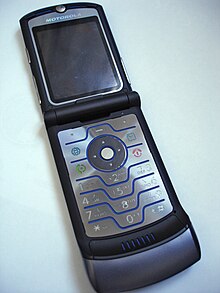Motorola RAZR
 |
|
| Series | Motorola Razr |
|---|---|
| Compatible networks | GSM Quad band |
| First released | November 2005 |
| Dimensions | 53 x 98 x 13.9 mm (3.9 in x 2.1 in x 0.54 in) |
| Weight | 3.5 oz (99.22 grams) |
| Memory | 13.5 MB Internal |
| Removable storage | microSD expandable up to 512 MB (1 GB with the latest firmware) |
| Display |
Internal: 176×220 pixel (2.2inch) TFT LCD, 262,144 colors |
| Connectivity |
GPRS Class 10 (4+1/3+2) slots 32-48 kbit/s Bluetooth Class 1 v1.0 mini-USB |
 |
|
| Manufacturer | Motorola |
|---|---|
| Availability by country | Q1 2005 |
| Weight | 125 |
| Memory | 64 MB |
| Display | QVGA, 2.2 inch, 262,144 colors, 320×240 |
| Rear camera | 2 megapixels (1600×1200) with LED flash |
 |
|
| Manufacturer | Motorola |
|---|---|
| Compatible networks | maxx V6:GSM 900/1800/1900MHz, UMTS 2100 with HSDPA maxx Ve:CDMA2000 1x 800/1900MHz with EV-DO |
| Availability by country | April 24, 2007 |
| Form factor | Clamshell |
| Dimensions | 53x104.5x15.5 mm |
| Weight | 107 g |
| Memory | 50 MB |
| Battery | 880 mAh (For United States), 900 mAh (For Europe, Australia and Asia markets) |
| Display | QVGA, 2.2 inch, 262,144 Colors, 320x240 |
| External display | 120x160, 65,536 Colors |
| Rear camera | 2 Megapixels 1600x1200 (maxx Ve has Auto Forcus) |
| Connectivity | Mini USB 2.0, Bluetooth 2.0 + EDR |
 |
|
| Manufacturer | Motorola |
|---|---|
| Availability by country | November 2009 |
| Weight | 105 g |
| CPU | MSM6675 |
| Memory | 303 MB Internal Memory, Micro SD Card |
| Display | Internal Screen : 240x320 pixels, TFT LCD, 262K colours, 2.2 Inch / External screen : Touch screen, 240x320 pixels, TFT LCD, 262K colours, 2.0 Inch |
| Rear camera | 5.0MP, Auto Focus, Flash Included |
Motorola Razr (styled RAZR, pronounced "razor") is a series of mobile phones by Motorola, part of the 4LTR line. They were first developed in July 2003 and were released in the market in the third quarter of 2004. The V2 was the first and the v3 was the main phone at the height of the series popularity.
Because of its striking appearance and thin profile, it was initially marketed as an exclusive fashion phone, but within a year, its price was lowered and it was wildly successful, selling over 50 million units by July 2006. Over the Razr's four-year run, the V3 model sold more than 130 million units, becoming the best-selling clamshell phone in the world to date.
The Razr series was marketed until July 2007, when the succeeding Motorola Razr2 series was released. Marketed as a more sleek and more stable design of the Razr, the Razr 2 included more features, improved telephone audio quality, and a touch sensitive external screen. The new models were the V8, the V9, and the V9m. However, Razr2 sales were not as good as the original, with consumers moving to competing products. Because Motorola relied so long upon the Razr and its derivatives and was slow to develop new products in the growing market for feature-rich touchscreen and 3G phones, the Razr appeal declined, leading Motorola to eventually drop behind Samsung and LG in market share for mobile phones. Motorola's strategy of grabbing market share by selling tens of millions of low-cost Razrs cut into margins and resulted in heavy losses in the cellular division.
In October 2011, Motorola resurrected the Razr brand for a line of Android smartphones; the Droid Razr for Verizon Wireless, otherwise also known simply as "Motorola RAZR" on other networks, improved variant Droid Razr Maxx. The new "Razr" line shares the trademark thinness as well as stylized tapered corners with the original.
The V3 was released in Q3 2004. The team of the V3 put together a number of design choices that set the device apart from the competition. The phone had the thinnest profile at the time on a clamshell set, sported an electroluminescent keypad made out of a single metal wafer and used an industry standard mini USB port for data, battery charger and headphones, all in an aluminum body with an external glass screen.
...
Wikipedia
